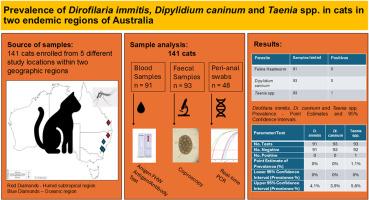Prevalence of Dirofilaria immitis, Dipylidium caninum and Taenia spp. in populations of cats from shelters and research colonies, in two endemic regions of eastern Australia
IF 1.7
Q3 PARASITOLOGY
Current research in parasitology & vector-borne diseases
Pub Date : 2024-01-01
DOI:10.1016/j.crpvbd.2024.100226
引用次数: 0
Abstract
There is a paucity of available prevalence data for key parasite species and genera infecting cats in Australia. The present study aimed to determine the prevalence of key parasites infecting cats in Australia, namely the feline heartworm, Dirofilaria immitis, and the cestodes Dipylidium caninum and Taenia spp. The prevalence of these parasites was assessed in cat populations in five separate locations of eastern Australia and within two geographical regions: humid subtropical and oceanic. A total of 141 cats were enrolled in this study. Of these, 91 were tested for D. immitis by feline heartworm antigen/antibody testing, 93 samples were tested for Di. caninum and Taenia spp. by faecal floatation and a subset of 48 cat samples were tested for Di. caninum and Taenia spp. by PCR performed on peri-anal swabs. Test results were negative for the two species with a single positive result observed for Taenia spp. Point estimates of prevalence were therefore 0% for feline heartworm and Di. caninum and 1.1% for Taenia spp. Associated 95% confidence intervals around the point estimate were 0–4.1% for feline heartworm, 0–3.9% for Di. caninum and 0–5.8% for Taenia spp. It should be noted that estimates were calculated using nominal values for test sensitivity and specificity; however, the overall prevalence of all three parasite species in these geographical regions is likely to be minimal based on the data from this study.

澳大利亚东部两个地方病流行地区收容所和研究聚居地猫群中的密螺旋体、犬双鞭毛虫和疟原虫的流行情况
关于澳大利亚猫感染的主要寄生虫种类和属的流行率数据很少。本研究旨在确定澳大利亚猫感染的主要寄生虫的流行情况,即猫心丝虫(Dirofilaria immitis)、绦虫(Dipylidium caninum和Taenia spp.)。 这些寄生虫的流行情况在澳大利亚东部五个不同地点的猫群中进行了评估,涉及两个地理区域:亚热带湿润地区和海洋地区。共有 141 只猫参与了这项研究。其中,91 份样本通过猫心丝虫抗原/抗体检测进行了白腹线虫病检测,93 份样本通过粪便漂浮法进行了犬二螨和疟原虫检测,48 份猫样本通过肛周拭子进行 PCR 进行了犬二螨和疟原虫检测。因此,猫心虫和犬二螨的流行率点估计值为 0%,犬二螨的流行率点估计值为 1.1%。应该注意的是,估计值是使用检测灵敏度和特异性的名义值计算的;不过,根据本研究的数据,这三种寄生虫在这些地理区域的总体流行率可能很小。
本文章由计算机程序翻译,如有差异,请以英文原文为准。
求助全文
约1分钟内获得全文
求助全文

 求助内容:
求助内容: 应助结果提醒方式:
应助结果提醒方式:


